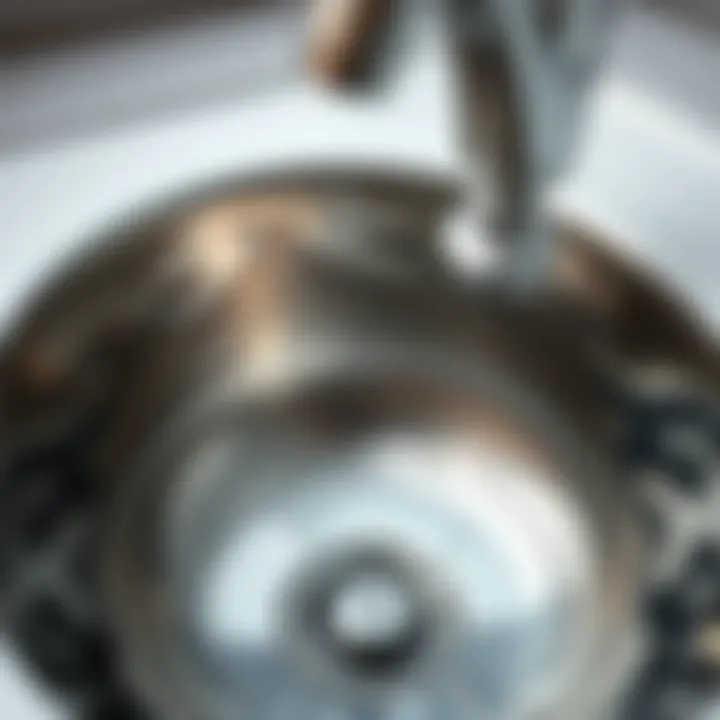Stainless Bathroom Sink: Functionality and Aesthetics


Intro
In the realm of home design, the bathroom often stands out as a personal sanctuary. One of the pivotal elements in this space is the bathroom sink, and stainless steel sinks have carved out a significant niche for themselves. Not only do they offer a sleek contemporary look, but they also promise durability and ease of maintenance. This article will be your fine companion on a journey through the intricate world of stainless bathroom sinks, highlighting their functionality, aesthetic charm, and how they can be the cherry on top of your bathroom design.
Understanding the latest trends is essential for any homeowner looking to modernize their space. The right sink can elevate the entire room’s vibe, making it not just a place for daily routines but a stylish retreat. As we unravel this guide, expect to learn about current trends, practical features, and tips for selecting the perfect sink that aligns with both your needs and personal style. Let’s dive into the vibrant waters of stainless bathroom sinks, blending function with flair.
Prelims to Stainless Bathroom Sinks
In the realm of modern bathroom design, the stainless bathroom sink stands tall as a symbol of functionality melded with sleek aesthetics. Choosing the right sink can make or break the entire ambiance of a bathroom, which is why it’s essential to grasp the myriad benefits that stainless steel can offer. This part of the guide will peel back the layers on why stainless bathroom sinks have become a go-to option for homeowners.
The Importance of Functionality
Functionality is key when it comes to bathroom sinks. Stainless steel sinks provide practical advantages that serve both the needs of the household and the demands of daily use. One of the foremost elements is the ease of cleaning. Unlike other materials, stainless steel's smooth surface resists grime buildup, making everyday maintenance a breeze. With a simple wipe-down, you can keep your sink looking spick and span, giving you more time to focus on the things that matter.
Benefits Beyond the Surface
Another significant aspect is durability. Stainless steel is engineered to withstand the trials of a bustling household. From the daily splashes of water to the occasional reckless handling of bathroom items, these sinks hold up remarkably well. Their resistance to scratches and dents ensures that they maintain their polished appearance despite the wear and tear of daily use.
"Selecting the right sink is an investment in both health and style, as it combines essential utility with flair."
Considerations in Aesthetic Appeal
On the aesthetics side, stainless sinks have a unique ability to harmonize with various bathroom styles. Whether your bathroom captures the spirit of a modern minimalist vibe or echoes rustic charm, a stainless steel sink fits seamlessly into the picture. This versatility is a huge selling point for homeowners keen on establishing a cohesive design.
Integration with Other Elements
Additionally, the reflective properties of stainless steel enhance light within a space, giving even smaller bathrooms a perception of openness. Light bounces off the calming surfaces, contributing to an overall brighter atmosphere that can uplift one's mood during those early morning routines.
In sum, understanding the value that stainless bathroom sinks bring to both homes and families is fundamental. This overview sets the stage for a deeper dive into the material's various advantages, styles, installation options, and maintenance practices in the sections to follow. Whether you are upgrading an existing space or building anew, this comprehensive guide on stainless bathroom sinks aims to equip you with the knowledge to make an informed choice that is both functional and visually appealing.
The Advantages of Stainless Steel
Stainless steel isn’t just a choice; it’s a statement. When it comes to bathroom sinks, this material packs a mighty punch in terms of benefits. Knowing the advantages can make all the difference when choosing the right sink for your sanctuary.
Durability and Longevity
Stainless steel is renowned for its remarkable durability. It can withstand the daily wear and tear that comes from constant use, making it a perfect fit for busy bathrooms. Picture a household where kids rush in and out, splashes here and there, or a frantic morning routine dominated by hurried hands. Stainless steel holds up exceptionally well under these conditions. It’s not just about surviving; it's about thriving. With proper care, these sinks can last for decades, often outliving their owners.
A good stainless sink is like an old friend—reliable, tough, and always there when you need it. Instead of fretting over potential dings or chips, homeowners can breathe easy knowing that their sink can handle life's rigors.
Resistance to Corrosion and Stains
Here’s the kicker: stainless steel also boasts impressive resistance to corrosion and stains. Unlike some materials that can rust or tarnish over time, quality stainless steel resists oxidation. It doesn't mind getting wet, which, let’s face it, is a common occurrence in bathrooms.
When you splash soap or toothpaste, you can wipe it down with ease. Gone are the days of scrubbing away unsightly spots; a soft cloth and mild detergent are often all it takes to restore its shine. Plus, stainless steel discourages the growth of bacteria, ensuring a cleaner, healthier bathroom.
"Choosing stainless steel for your bathroom sink is not just a trend, it's a practical solution that pays off over time."
Aesthetic Versatility
Aesthetics also play a huge role in the appeal of stainless steel sinks. They come in a variety of styles and finishes, which allow them to fit seamlessly into both modern and traditional settings. Whether you prefer the sleek finish of a polished sink or the understated feel of brushed metal, there's a stainless steel option tailored to your taste.
Imagine a contemporary bathroom adorned with striking tiles and elegant fixtures; a stainless sink can enhance that look without overwhelming other elements. Moreover, the metallic sheen complements a wide color palette, giving you the freedom to play around with your decor.
In a world where first impressions matter, the graceful functionality of stainless steel sinks emerges as a crowd-pleaser. They can be the anchor to your bathroom’s design narrative, combining style with substance.
By understanding the strengths of stainless steel, homeowners can better appreciate its role within bathroom design. The benefits stretch beyond mere looks; they encompass longevity, ease of maintenance, and why many consider them the gold standard in sink materials.
Types of Stainless Bathroom Sinks
When it comes to selecting a stainless bathroom sink, understanding the various types available is crucial. The choice of sink can significantly influence both functionality and the overall aesthetic of your bathroom. Each type offers unique advantages and seamlessly integrates into different styles and layouts. This section provides an in-depth look at four popular types of stainless bathroom sinks: under-mount, top-mount, vessel, and wall-mounted, enabling you to make an informed decision for your space.
Under-Mount Sinks
Under-mount sinks are installed beneath the countertop, creating a sleek and seamless look. This design is particularly advantageous for those who favor a modern and minimalist aesthetic. One of the benefits of this type of sink is that it minimizes the messy buildup of grime and debris around the rim, as there is no top lip to catch dirt. Often made from high-quality stainless steel, these sinks are durable and resistant to scratches and dents.
Additionally, the under-mount style allows for easier cleaning, as you can simply wipe debris straight into the sink without obstacles. It's also worth noting that they pair beautifully with solid surface countertops, enhancing the overall appearance of your bathroom.
Top-Mount Sinks
Top-mount sinks, often referred to as drop-in sinks, are designed to sit on top of the countertop. This means that the bowl is visible above the surrounding counter surface. One significant advantage is their easier installation and lower cost compared to under-mount sinks. They can fit into virtually any existing counter, making replacements a straightforward process.
However, the raised lip around the sink can trap water and debris, requiring more regular maintenance. Still, many homeowners appreciate their robustness and the variety of styles available in this category. If you’re on a budget but want a stylish stainless sink, a top-mount option might be the way to go.
Vessel Sinks
Vessel sinks have surged in popularity for their artistic appeal and unique design. Sitting atop the counter, these sinks resemble elegant bowls or basins. They are excellent for creating a focal point in your bathroom, often acting as the centerpiece of your design. Its heightened placement makes washing hands or brushing teeth a more comfortable endeavor, especially for taller individuals.
Moreover, vessel sinks are available in a myriad of designs, shapes, and finishes. You can find styles that range from modern and sleek to more traditional, incorporating intricate patterns or textures. However, because they sit above the counter, they might require more height in your vanity or cabinet. Ensure to consider this when planning your bathroom layout.
Wall-Mounted Sinks
Wall-mounted sinks offer a unique space-saving solution, making them ideal for smaller bathrooms or powder rooms. Attached directly to the wall, these sinks free up floor space and contribute to a more open feel. This type of sink is particularly functional in high-traffic areas, as it’s easy to maintain and can be conveniently installed at a height that suits individual preferences.
Despite their compact nature, wall-mounted sinks online don’t compromise on style. Many designs feature sleek lines and modern finishes, allowing them to blend seamlessly into contemporary settings. As you might expect, mounting these sinks does require some consideration of plumbing and wall support, making installation slightly more complex.
Choosing the Right Size and Shape
Selecting the proper size and shape for your stainless bathroom sink plays a vital role in both functionality and style. A well-chosen sink can dramatically improve the workflow and aesthetic of your bathroom, converging practical needs with personal taste. The dimensions of the sink determine how well it fits within your vanity or counter space. If the sink is too large, it might dominate the area, making it feel crowded. Conversely, a sink that is too small could lead to usability issues, especially in bustling households. It’s a balancing act that requires careful consideration of the overall design and space constraints.
Apart from size, the shape of the sink contributes significantly to the overall vibe of the bathroom. Each form — rectangular, round, or square — has unique attributes that cater to different aesthetics and practical requirements.
Standard Dimensions
Understanding the standard dimensions of bathroom sinks is essential when you’re in the market. The typical sink offers dimensions around 16 to 20 inches in width and 12 to 15 inches in depth. These measurements accommodate most bathroom setups while ensuring ample functionality.
- Depth: A depth of 5 to 8 inches provides sufficient capacity to hold water without splashing.
- Height: Standard sink heights range from 30 to 34 inches from the floor, aimed at user comfort.
When planning the installation, take note of these measurements; they are more than just numbers but guidelines grounded in ergonomic design.
Shape Considerations


Rectangular
Rectangular sinks are often regarded as the most versatile option. The key characteristic of a rectangular sink is its spacious surface area, which is advantageous for washing hands, brushing teeth, and other daily tasks. They tend to fit well in modern and traditional bathrooms alike, becoming a staple in countless decor styles.
A unique feature of the rectangular shape is its potential for a fitted look, which can be easily integrated into various countertop materials. However, one disadvantage may be the angular edges that could be tricky to clean if not maintained properly.
Round
Round sinks are harmonious and often associated with softer aesthetics. Their key characteristic is the absence of sharp corners, offering a more gentle look that can complement organic design styles. Being compact, they are a favored choice for smaller bathrooms or powder rooms where space is at a premium.
The unique feature of a round sink is that it can encourage a more approachable feel in a room, with its fluid lines. Nevertheless, one might find functionality challenged in terms of surface area, making round sinks less favorable for multi-use settings.
Square
Square sinks present a modern and bold design choice. Their key characteristic is symmetry, which can align beautifully with square cabinets or tiles, creating a uniform look in your bathroom. Square sinks can often feel spacious due to their consistent dimensions, providing ample room to carry out daily routines.
A unique advantage is their ability to pair well with square faucets, enhancing the cohesive aesthetic. However, they can be tricky in terms of cleaning and may not channel water efficiently, increasing the risk of splashes in a busy bathroom.
In summary, determining the right size and shape of your stainless bathroom sink is not merely an afterthought. It's an essential decision that influences both functionality and the aesthetic quality of the space, ensuring that the sink fits its environment beautifully while serving its purpose when needed.
Design Considerations
Selecting a stainless bathroom sink is not merely about functionality; it's also a critical element of your bathroom's aesthetic appeal. The design of your sink should complement the overall decor of your space, which can amplify both beauty and utility. A well-chosen sink can tie together various elements in your bathroom, such as cabinetry, tile, and fixtures, creating a harmonious atmosphere that feels both welcoming and stylish.
When contemplating design considerations, several specific aspects come into play. First, the style and size can significantly dictate how well the sink integrates within the existing space. Also, finishes and textures can dramatically alter the sink's personality and feel. Each of these components should align with your vision for the bathroom to ensure that the sink does not just function well but also contributes positively to the overall experience.
Matching with Bathroom Decor
A stainless bathroom sink can serve as both a focal point and a subtle complement to your bathroom's decor. When choosing a sink, it's imperative to consider the existing design elements and color palette. For instance, if you have a traditional space with wood tones and classic fixtures, a brushed stainless steel sink might offer a modern contrast that nonetheless feels at home. Conversely, in a contemporary setting with sleek lines and minimalistic aesthetics, a polished sink may amplify the elegance without overwhelming the other design features.
It’s worth noting that the sink should resonate with other elements. For example, if the cabinetry showcases darker woods, consider finishes that either match or offer a pleasing contrast. This resonates with the idea that every element in your bathroom can contribute to a harmonious visual experience, ensuring that your stainless sink looks intentional and well-placed rather than an afterthought.
Finish and Texture Options
The finish and texture of your stainless sink can greatly influence both its appearance and practicality. Two of the most common finishes are brushed and polished. Each offers distinct advantages and may suit varying tastes and needs.
Brushed Finish
A brushed finish features a matte appearance with finely textured lines, which not only provides a sophisticated look but also conceals water spots and smudges better than its shiny counterpart. This makes it an ideal option for families or for individuals who may not have time for constant upkeep. Its subtle glow can afford a timeless quality and integrate well with different styles, from rustic to modern. The durability of a brushed finish means that scratches are less likely to be visible, reinforcing its practical appeal.
On the flip side, while this finish can hide imperfections, it may not shine as brilliantly as a polished sink and might require a bit more effort to maintain the desired texture over time, especially if exposed to harsh cleaning chemicals.
Polished Finish
In contrast, a polished finish delivers a striking, gleaming look that captures light beautifully, making any bathroom feel more open and bright. This finish accentuates the modern vibe, appealing to those who prioritize aesthetics. A polished sink can stand out as a statement piece, enhancing the elegance and sophistication of your bathroom.
However, it does come with its own challenges. The shining surface shows water spots and fingerprints more easily, meaning it requires more frequent cleaning to maintain its luster. Moreover, it can be prone to scratching if not handled with care. If you favor a striking visual that calls attention, a polished finish might align with your vision, provided you're ready to keep it looking pristine.
In summary, choosing finishes thoughtfully can sharpen the overall look of your bathroom while also meeting practical needs. Design isn’t just about what looks nice; it’s about how it feels and functions too.
Understanding these elements not only supports aesthetic satisfaction but also ensures your stainless bathroom sink is truly a functional, harmonious part of your bathroom.
Installation Options for Stainless Sinks
When selecting a stainless bathroom sink, understanding the installation options is key. Proper installation ensures functionality and aesthetics in your bathroom. Moreover, the method you choose can impact the longevity and overall performance of your sink. This section will delve into the different installation options available, with a focus on the benefits and considerations of each method.
Professional Installation
Opting for professional installation can bring peace of mind. Hiring skilled professionals means that your sink will be installed following specific guidelines, often ensuring optimal performance. Here are some significant advantages of having an expert install your stainless sink:
- Quality Assurance: Professionals are well-versed in the nuances of installation. Their experience helps prevent common mistakes that can lead to issues in the future, such as leaks or uneven mounting.
- Time Efficiency: They can complete the installation in a fraction of the time it might take a novice, which means less inconvenience for your household.
- Proper Tools: Experts have the right tools and know-how to handle different sink types and configurations, ensuring that everything fits beautifully and functions correctly.
However, it’s important to consider the costs associated with professional installation. Depending on your location and the complexity of installation, prices can vary. It’s wise to get multiple quotes when looking for the right installer.
DIY Installation Guidelines
If you're a more hands-on homeowner, a DIY installation might tickle your fancy. And while this approach can be cost-effective, it’s essential to proceed with caution. Here are some fundamental guidelines to consider:
- Gather the Necessary Tools: Make sure you have access to basic plumbing tools, such as a wrench, screwdriver, and caulking gun. Having everything on hand before you start can save you plenty of headaches.
- Follow Manufacturer Instructions: Each sink comes with detailed instructions—make sure you adhere to them closely. Ignoring these can lead to issues down the line, from misalignment to improper sealing.
- Prepare Your Work Area: Clear the area around your sink to work easily. A clutter-free workspace can help you maintain focus and prevent accidents.
- Check Existing Plumbing: Inspect your current plumbing connections before you begin. Ensure they are compatible with your new sink. You don’t want to learn about incompatibilities halfway through!
- Seal Properly: Use caulk or plumber’s putty to create tight seals. This step is critical to prevent water leaks.
- Test for Leaks: After installation, run water through the sink and check for any leaks. If you spot any, turn off the water immediately and rectify the issue.
While DIY might save a few bucks, it's important not to overestimate your skills. If at any point you feel in over your head, don’t hesitate to call in the professionals.
"A hesitant hand can lead to a big splash; better safe than soggy!"
Choosing between professional and DIY installation for your stainless sink depends largely on your skill level, budget, and time constraints. Each option has its merits, and the choice should align with your personal preferences and circumstances.
Maintenance and Care
Taking care of your stainless bathroom sink is essential for maintaining its appearance and functionality. Regular maintenance not only prolongs the lifespan of the sink but also reflects an investment in your home’s aesthetics. Cleanliness should be at the forefront because, let’s face it, nobody wants to stare at smudges or water spots in a space that's meant to be serene. Furthermore, understanding how to care for your sink equips you with knowledge that can save you both time and money in the long haul.
Daily Cleaning Practices
Daily cleaning is the bread and butter of sink maintenance. It doesn't take much time, yet, it can make a world of difference:
- Warm Water and Mild Detergent: At the end of the day, a simple rinse with warm water and a bit of mild dish soap can keep your sink looking fresh. Wipe it down with a soft cloth — this minimizes scratches and avoids damaging the surface.
- Avoid Abrasive Cleaners: It’s tempting to use those heavy-duty scrubs sometimes, but they can leave behind scratches or diminish the shine. Stick with gentle cleansers meant for stainless steel.
- Rinsing and Drying: After cleaning, give your sink a rinse. That's crucial, as some detergents have residues that can dull the shine. Follow this with a soft dry towel to prevent any water spots from making an appearance.
These simple daily practices can maintain your sink's luster without much fuss.
Dealing with Scratches and Marks
Let’s be honest: scratches happen. Whether it’s a clumsy moment with a pot or a rogue fork, knowing how to deal with them is important.
- Buffing Out Minor Scratches: For light scratches, buffing with a non-abrasive sponge or a cloth can often do the trick. Using a bit of baking soda mixed with water forms a mild abrasive that can gently remove those marks.
- For Deeper Scratches: If you find a scratch that just won't budge, you might want to consider using a specialty scratch remover designed for stainless steel. Apply as directed and buff away. It should help in restoring some of that original sheen.
- Preventive Measures: To protect against future scratches, consider using protective mats or trivets when placing heavy items in the sink. Prevention is often easier than remedy!


Maintaining the aesthetic appeal of your sink also involves addressing these imperfections swiftly.
Preventing Water Spots and Stains
Water spots can be a nuisance, often diminishing the beauty of stainless steel sinks. Fortunately, there are practical steps to minimize their occurrence:
- Use a Water Softener: If your home has hard water, consider a water softening system. The minerals in hard water contribute to water spots forming. A solution to this problem can save you from constant cleaning.
- Regular Wiping: After each use, it takes mere seconds to wipe the sink down. Keeping the sink dry and clean directly prevents spots from forming.
- Sealants or Coatings: There are specific sealants available that can provide a protective coat over the stainless steel. This helps in repelling water and minimizing the appearance of stains.
By keeping those pesky spots at bay, your stainless sink can truly shine.
Remember, regular maintenance makes all the difference in keeping your bathroom looking spick and span and ensuring that everything runs smoothly.
For additional guidance on maintaining stainless steel surfaces, check related resources on Wikipedia or Britannica.
Common Issues with Stainless Bathroom Sinks
Understanding the common issues associated with stainless bathroom sinks is essential for anyone considering this material for their home. While these sinks offer numerous benefits, they are not completely without their quirks. Homeowners often face challenges that, if left unaddressed, can detract from both functionality and visual appeal. In this section, we’ll explore two prevalent issues: rust and corrosion misconceptions, as well as drainage problems. Gaining insight into these concerns can aid in better decision-making and long-term satisfaction with your selection.
Rust and Corrosion Misconceptions
One of the most enduring myths surrounding stainless bathroom sinks is the belief that they are entirely resistant to rust and corrosion. While it's true that stainless steel is engineered to resist these issues, it is not invincible. For example, if abrasive cleaners or harsh chemicals are frequently used, they may damage the protective layer of chromium oxide that guards against rust.
A common misconception is that all stainless steel sinks are created equal; this couldn’t be further from the truth. The gauge, or thickness, of the steel can play a significant role in its durability. Thinner gauges, like 22 or 24, can be more prone to dents and scratches, which compromise that protective layer. Understanding the different grades—like 304 or 316—also helps clarify what to expect in terms of corrosion resistance.
"A little knowledge goes a long way. One small scratch can snowball into bigger issues if not properly addressed."
Drainage Problems
Drainage issues can be an unsightly nuisance for homeowners. Clogs can stem from various sources, but one common problem in stainless sinks involves the design of the drain itself. Poorly designed drains can trap solids, leading to a buildup that eventually clogs the system. As their sizes vary, it is essential to ensure your sink’s drain is compatible with your plumbing system.
Another concern is that stainless steel can be installed improperly, leading to an uneven slope. This imperfect alignment can create pooling water, which may, over time, contribute to mild staining or other water-related problems. It’s crucial that during installation, the sink is leveled properly. Observing for standing water after each use is a simple way to spot drainage issues before they escalate.
In addressing drainage issues, one must not underestimate the power of routine maintenance. Regularly cleaning your drains with hot water or vinegar can help keep clogs at bay. Familiarity with your plumbing system can save headaches down the line, making it an invaluable component of home ownership.
By being aware of these common issues, homeowners can take proactive measures to ensure that their stainless bathroom sinks remain both functional and beautiful long after installation.
Trends in Stainless Bathroom Sink Design
The design of bathroom sinks has evolved over the years, particularly with the growing popularity of stainless steel. Understanding current trends is essential for anyone looking to upgrade their bathroom space. These trends are not merely aesthetic; they encompass practical benefits, influencing everything from ease of cleaning to durability. Keeping up with trends helps homeowners make informed decisions that align with their style and functional needs.
Sustainable Materials
Sustainability is no longer just a buzzword; it's an important concern for many homeowners today. When it comes to bathroom sinks, the trend towards sustainable materials is gaining traction. A stainless steel sink already has a leg up since it is wholly recyclable. This not only reduces waste but also ensures that your sink can be repurposed at the end of its life cycle. Plus, many manufacturers are adopting practices to source their steel from recycled materials, giving an eco-friendly spin to your choice.
There are a couple of key factors to consider here:
- Certifications: Look for certifications from organizations that advocate for sustainable practices, like the Forest Stewardship Council (FSC) and Leadership in Energy and Environmental Design (LEED).
- Local Sourcing: When possible, opt for products made closer to home. This not only cuts down on transportation emissions but also supports local economies.
Minimalist Aesthetics
Less is often more in design, and this rings especially true in the world of bathroom sinks. Minimalist aesthetics focus on simplicity and functionality while maintaining a sleek look. Stainless steel fits this bill perfectly. Its reflective surface enhances light and creates an airy feel in even the smallest of bathrooms.
The minimalist trend leans toward:
- Clean Lines: Think of sinks with smooth, sleek silhouettes without excessive embellishments. This creates a modern look that seamlessly integrates into any decor.
- Hidden Hardware: Many new designs eliminate visible plumbing fixtures, opting for streamlined looks that keep the focus on the sink itself.
This shift toward minimalist designs also embodies practicality, making cleaning and maintenance less of a chore.
Smart Technology Integration
As technology leaps forward, the integration of smart features into stainless bathroom sinks is becoming more commonplace. Gone are the days when sinks were merely functional; they are evolving into tech-savvy components of modern homes. These innovations often include features like touchless faucets or integrated water filtration systems, but the possibilities are expanding.
With smart technology integration, you may find:
- Sensor Controls: This can turn the faucet on and off automatically, making it easier to avoid cross-contamination from dirty hands.
- Built-in Water Recycling Systems: These innovative systems can reduce water waste by filtering and recycling water from the sink for uses like irrigation.
As homeowners begin to prioritize convenience and sustainability, it's being seen as a good investment, enhancing both functionality and efficiency in daily tasks.
"Incorporating these design trends into your bathroom not only improves functionality but also aligns your space with modern values, allowing both beauty and practicality to thrive."
Stainless steel bathroom sinks are not just about their shiny facade; they are the epitome of contemporary utility combined with design. The lanes of sustainable materials, minimalist aesthetics, and smart technology are reshaping this essential item in ways that cater to modern lifestyles.
Budget Considerations for Stainless Sinks
Understanding the budget involved in selecting a stainless bathroom sink is crucial for anyone embarking on a bathroom renovation or simply replacing an outdated fixture. A well-planned budget can significantly influence the available options, ensuring that homeowners don't just wander into constant impulse buys but instead make choices that reflect both personal style and practical needs.
When considering the budget for a stainless sink, several factors come into play: the type of sink, its design, and even specific customizations or add-ons like faucets and fittings. Aligning the budget with your vision can lead to changes, either upward or downward in your selections without compromising on quality. Notably, the investment in a stainless steel sink can vary greatly, especially when bearing in mind durability and long-term performance which can make a seemingly higher price worthwhile.
Price Range Overview
The prices of stainless bathroom sinks can range widely depending on a variety of factors. To give you an idea, here’s a brief overview of typical price ranges:
- Basic Stainless Sinks: Around $100 to $300. These are often simpler designs and may not have extensive custom features.
- Mid-Range Options: Typically between $300 and $700. These models often boast better craftsmanship, more aesthetic options, and added features.
- High-End Sinks: Ranging from $700 to more than $1,200. These sinks usually offer unique designs, custom shapes, and premium quality materials.
The price can also fluctuate due to the sink shape and mounting style. For instance, under-mount sinks generally cost more than top-mount ones due to the complex installation process.
Cost-Effective Alternatives
If the price of stainless sinks feels a bit daunting, there are various alternative approaches that maintain visual appeal without breaking the bank.
- Look for Discounts: Websites like Wayfair and Overstock frequently run promotions or clearance sales that can offer substantial savings.
- Consider Lesser-Known Brands: While popular brands like Kohler and Moen offer reliability, lesser-known manufacturers can provide similar quality at lower prices.
- Choose a Slightly Compromised Finish: Instead of high-polished stainless steel, opting for brushed finishes can sometimes lower the price. They also tend to hide scratches better, reducing the need for replacements.
- Second-Hand Options: Often, you can find high-quality used sinks on platforms like Facebook Marketplace or Craigslist, usually in good condition at half the original price.
"Investing wisely in a bathroom sink today can prevent costly replacements down the line."


By focusing on these budget considerations, you can navigate the selections available and find the perfect stainless sink that fits your needs and your financial plan.
How Stainless Sinks Compare to Other Materials
When it comes to bathroom sinks, selecting the right material can have a significant impact on both functionality and aesthetics. One of the most compelling materials available on the market today is stainless steel, but it's essential to evaluate how it stacks up against other popular choices like ceramic and composite sinks. In this section, we will delve into the attributes, advantages, and possible drawbacks of each of these materials, to help you make an informed decision for your bathroom.
Ceramic Sinks
Ceramic sinks have long been a staple in bathrooms around the world, and for good reason. Known for their classic charm and smooth, glossy finish, ceramic offers an elegant look that meshes well with a variety of bathroom styles.
- Aesthetic Appeal: Ceramic sinks come in myriad designs, from traditional to modern. They often boast vibrant colors and can integrate beautifully with other decor elements.
- Easy to Clean: The non-porous surface means that ceramic is resistant to stains, making it easier to maintain a pristine appearance without much effort.
However, ceramic sinks do have some drawbacks:
- Fragility: One downside to ceramic sinks is their susceptibility to chips and cracks if mishandled. If you drop a heavy item in the sink, or if it encounters a strong impact, you might end up with an unsightly repair job on your hands.
- Weight: They can be surprisingly heavy, complicating both installation and potential replacements later on.
Despite these drawbacks, homeowners still favor ceramic sinks for their classic looks and ease of matching with various bathroom designs.
Composite Sinks
Composite sinks, made from a blend of materials like acrylic and resins, offer a unique alternative to traditional sinks. These sinks are a relatively newer entrant to the bathroom arena and have gained traction for their versatility and modern styling.
- Durability: Composite materials are often very durable and resistant to cracking, scratching, and fading. This makes them ideal for busy bathrooms where wear and tear might be a concern.
- Variety of Colors and Patterns: You can find composite sinks in a rich variety of colors and textures, allowing for customization that can cater to any style preference. Unlike ceramic, they can mimic stone or granite finishes without the heavy weight.
Yet, they’re not without their limitations:
- Heat Sensitivity: Composite sinks can be heat-sensitive, meaning that placing very hot items directly on them can cause damage. Being cautious with hot pots or irons is necessary.
- Maintenance: While they are generally easier to maintain than ceramic, the surface might require specific cleaning products to avoid dulling its shine.
In summary, while ceramic sinks are lauded for their timeless appeal and simplicity of maintenance, they can break easily. Composite sinks, on the other hand, offer modern aesthetics along with durable performance, though they require mindful usage to avoid damage.
Environmental Impact of Stainless Steel
Understanding the environmental impact of stainless steel is integral to making informed choices about bathroom fixtures. As homeowners increasingly seek sustainability, knowing how materials affect the planet is crucial. Stainless steel, with its durability and flexibility, certainly stands out, but we must examine both its benefits and pitfalls in the broader environmental context. This section unfold our thoughts on recyclability and sourcing practices that influence the sustainability of stainless bathroom sinks.
Recyclability of Stainless Steel
One of the prime benefits of stainless steel is its exceptional recyclability. Unlike many materials that face hurdles in the recycling process, stainless steel can be repurposed with ease. In fact, up to 88% of stainless steel is recycled globally. When a sink reaches the end of its usability, it doesn’t have to end up in a landfill. Instead, it can be melted down and recreated into new products or sinks, reducing waste.
Key points on recyclability include:
- Energy Efficiency: Recycling stainless steel uses only a fraction of the energy compared to producing new steel from raw materials, which helps to lessen carbon emissions significantly.
- Closed-loop System: The recycling process is often a closed-loop system, meaning the quality of the material remains consistently high, ensuring that new products can be of the same standard as the original.
- Waste Reduction: This reinforces a reduction in raw material extraction, helping to preserve natural resources and minimize habitat destruction.
"The process of recycling stainless steel not only conserves resources but actively combats pollution and energy waste."
Sustainable Sourcing Practices
Sustainable sourcing practices involve the consideration of how raw materials are obtained and processed. Not all stainless steel is created equal; where it comes from matters. Manufacturers committed to sustainability often use recycled materials in their products, significantly reducing the environmental footprint. Additionally, sourcing practices that consider ethical and environmentally friendly origination play a vital role in the overall sustainability of stainless steel appliances.
Considerations for sustainable sourcing include:
- Local Sourcing: By sourcing materials locally, manufacturers can reduce the carbon footprint associated with transportation. This contributes to overall sustainability.
- Ethical Mining Practices: Responsible mining operations that adhere to environmental regulations are crucial. This minimizes soil erosion, protects water quality, and respects local communities.
- Transparency: Consumers are increasingly favoring brands that are open about their sourcing practices. Being informed about the origin of materials fosters trust and confidence in product quality.
Customer Reviews and Insights
When it comes to selecting stainless bathroom sinks, the voices of those who have already made the choice matter immensely. Reviews from actual users provide a practical insight that can’t be found in glossy brochures or flashy advertisements. They reveal real-world experiences, from installation processes to daily use, helping potential buyers navigate the myriad of options available.
Understanding user feedback: People often share their triumphs as well as their hiccups. In exploring customer reviews, you get a balanced perspective. You won't just have the rose-tinted glasses on but instead a wide-ranging view of the good, the bad, and the ugly. For instance, someone might rave about the durability of their sink or highlight how easy it is to clean. Conversely, another user might caution about scratches with certain finishes or point out specific installation challenges. This breadth of feedback is vital in making informed decisions, beyond the manufacturer claims.
"User reviews offer a pragmatic lens into the day-to-day utility of your chosen sink, pinpointing strengths and weaknesses that no marketing can capture."
Benefits of tapping into reviews:
- Authenticity over Hype: Many reviews come from proud homeowners who want to share their insights, lending trust to the information.
- Identifying Trends: If numerous users mention a particular feature, it might indicate its significance, like ease of maintenance or an aesthetic that blends seamlessly into various bathroom styles.
- Comparative Insights: Feedback often includes direct comparisons with other sink types or materials, enabling users to conduct their own mini-analysis before purchasing.
Considerations while reading: Not all feedback carries the same weight. It's worth taking a moment to consider the context behind reviews:
- Check the number of reviews: A handful of glowing comments may not reflect the general sentiment.
- Look for detailed experiences: Reviews that discuss specific details of use, installation, and maintenance often provide more reliable insights.
- Consider the date: Sinks and fixtures can evolve over time, so ensure that you're looking at recent reviews to get an accurate picture of the current product quality.
Analyzing User Feedback
Delving into user feedback reveals essential details about functionality and appearance. Many reviews offer insights into how a sink performs under daily use. Homeowners frequently note aspects like the sink's depth, which can affect washing larger items, or how the finish holds up against everyday wear and tear.
Additionally, some users delve into aesthetic considerations. They might describe how a brushed finish appealed to their contemporary bathroom or how easy a polished surface is to coordinate with other fixtures. Reviews emphasizing such points can direct you to options that align with your personal sense of style.
Furthermore, product ratings can provide metrics. A star-based system offers a snapshot of how consumers view their purchase at a glance. However, it’s always wise to read the accompanying comments for context.
Top Recommendations Based on Reviews
Drawing from user feedback across platforms, several stainless bathroom sinks consistently receive high marks:
- Kohler K-2210-0: Known for its reliable performance and sleek design, this sink appeals to those seeking a blend of functionality and elegance.
- Moen 2200: Users have praised its easy installation and the durability of the finish, making it a popular choice for families.
- American Standard StyleSink: With its deep basin and modern look, many users highlight its practicality for daily use and aesthetic appeal.
When shopping, look for models that have garnered positive feedback for specific features important to you—be it aesthetics, ease of installation, or overall durability. In the end, customer insights not only shine a light on products worth exploring but also help create a more fulfilling purchasing experience.
Culmination and Final Thoughts
As we've navigated through the various aspects of stainless bathroom sinks, it's clear that they represent more than just a functional component in any home. They meld practicality with aesthetic appeal, making them a choice worthy of consideration for homeowners and housewives alike.
In a bathroom, the sink becomes a focal point, not merely for washing hands or brushing teeth, but as an integral part of the overall design. Selecting a stainless steel sink means investing in a durable product that can withstand the rigors of daily use, while still offering a sleek, modern look. The advantages—such as resistance to corrosion and ease of maintenance—highlight why so many are drawn to this material.
"A well-chosen sink can elevate the entire vibe of your bathroom, bridging style and functionality seamlessly."
While the variety of styles, from under-mount to vessel sinks, allows for personal expression, it is crucial to assess individual needs when making a choice. Space, shape, and mounting style can significantly impact both functionality and visual appeal, so careful consideration here will pay dividends in your satisfaction.
Moreover, this guide emphasizes the importance of maintenance. Regular cleaning and proactive care will ensure your sink not only retains its shine but also functions optimally. The allure of stainless steel is not just in its initial purchase, but in its long-term usability and aesthetic integrity.
Finally, as we venture into trends like sustainable sourcing and smart technology integration, it’s crucial to remain informed. The modern homeowner values not just quality, but also the environmental footprint of their choices. By selecting a quality stainless bathroom sink, one can make a responsible decision without compromising on style.
In summary, investing in a stainless bathroom sink is a decision that strikes a balance between function and elegance. It’s an asset that reflects not only personal style but also thoughtful consideration of durability and care. As we conclude, remember that the choice you make can transform an ordinary space into something lovely and highly functional.



